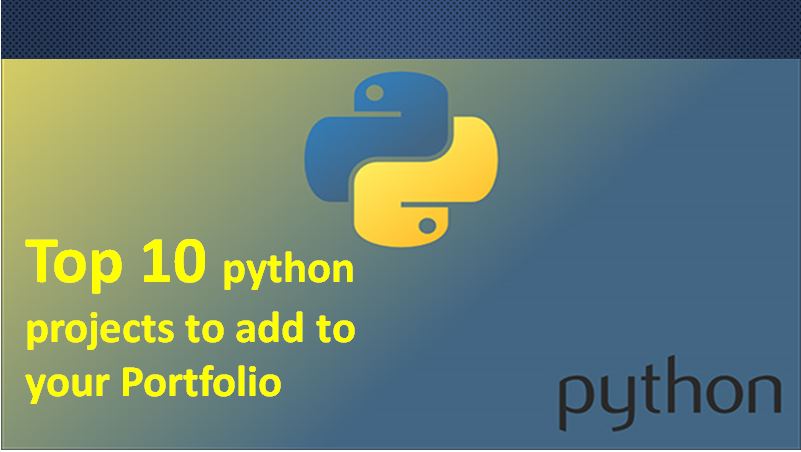
Top 10 python projects to add to your Portfolio
There’s no uncertainty that Python is one of the most well-known programming languages in the world. In the course of past ten years, Python has developed to become one of the top 3 languages that developers use. According to the 2020 Stack Overflow survey, over 40% of developers are right now working with the language, and an extra 30% can hardly wait to learn Python. But numerous learners finish an Intro to Python course and don’t know where to begin using their newfound skills – the possibilities are huge!
It is also challenging to figure out what you should do with it once you’ve learned it! In the event that you’ve been pondering,”What can I be able to do with Python?” then this article will cover 10 different projects of Python to assist you overcome that feared coder’s block.!
1. Organize files on your machine
One of the easiest tasks Python is utilized for is automatically organizing documents on your machine. Activities like renaming, copying, and moving hundreds of files can be performed in seconds with a Python script.
For example, if you need to tag all the music files your own and log all that metadata into a database, you need to open each and every song in your loved media player, manually add all the tags, and record the song in an Excel spreadsheet… or you could write a Python script to accomplish such work for you!
Here comes which is a free and open-source software written in Python code and helps you organize your music files in a snap. Their website says, “If beets doesn’t do what you need, composing your own plugin is incredibly simple if you know a little Python coding!”
2. Build dynamic websites
Static sites are incredible for certain applications, yet other websites have more dynamic content and therefore require high robust functionality (for example: hosting videos, managing client accounts, and accessing a database). If you’re hoping to develop a more feature-rich website, at that point Python web frameworks like Django and Flask might be more your speed.
Examples in real life include Instagram that is built with Django or Pinterest which uses Flask. Both sites has ability to handle high resolution images, complex client interactions, and responsive web design elements—with Python running behind it all.
3. Train a neural network
Deep learning has blasted onto the tech scene in recent years, and neural networks has become the superstar. These high-level machine learning models mimic the human brain and permit machines to learn by consolidating new information into their current algorithm.
Uber company use neural networks to associate riders to rideshare drivers and even to improve the quality of food and restaurant suggestions. Python is the main focus point in their toolkit: Uber says the deep learning library PyTorch is a staple for building their algorithm.
Python offers different frameworks for deep learning, like Keras and TensorFlow. You can utilize these frameworks to develop your own neural networks, you’ll gain an expertism that will be sought for years to come!
4. Make recommendations
Another famous machine learning use case is the recommender engine. You can probably see this action while shopping on the web: at some point on your screen, you’ll see a section titled something like Customers who viewed this also viewed…
But recommending items to clients can get complicated. Fortunately, Python offers a huge number of tools (like NumPy, Pandas, Scikit-Learn, and more) to make the development process much smoother. This data science stack integrates well with big data frameworks like Hadoop, allowing organizations like Spotify and Netflix to perform data analysis and recommend music and movies to clients.
5. Visualize data
For organizations to make the best business choices, they need to gather huge amount of data—and they should be able to see it as well. Once again, Python provides excellent of data visualization libraries to help make it easier for you to really see the insights in data.
With Seaborn and Matplotlib, you can easily create charts, graphs, and maps that represent your data in a visually appealing format. You can add interactivity with libraries like Bokeh, and deploy your visualization as a Docker web application.
For a genuinely standout project, try building a dashboard that automatically creates and updates visualizations in real-time for a dataset of your decision. Python integrates effectively with external tools like Tableau only for this purpose.
6. Scrape data from the web
Obviously, projects discussed in this article would not be possible without data! The Internet is a goldmine with regards to information. Still, lot of data has to be collected before you utilize it for training models, make visualizations, or do anything else.
With the help of Python, you can scrape data easily from websites using libraries like Selenium, ScraPy, and BeautifulSoup. Moreover, Python will easily integrate with available APIs to help you pull down organized data quickly and proficiently.
7. Build mobile applications
Nowadays days it seems practically unimaginable for us to operate without mobile devices. As of June 2020, it’s assessed that around 3.5 billion people own smartphones—which means over 45% of the Earth’s population. If you’re hoping to cash in on the mobile app market, then now’s the time!

You may feel that mobile apps can only be coded with platform-specific programming languages, however that is not really the case. For example, Kivy is a Python framework that allows you to create cross-platform mobile apps that will reflect the native UI of the system it’s running on. Dropbox utilizes Python to build its mobile app, which runs effortlessly on Windows, macOS, and even some Linux distributions.
8. Deploy a social media bot
Billions of individuals across the world use social media to connect with friends, family, and coworkers. They promote products and services and offer their opinions, stories, and ideas. Be that as it may, with so much content being generated every day, it can be overwhelming to manage all of your accounts manually.
Once again, Python steps in with an automated arrangement. Python makes easy to create bots that will deal with a lot of the social leg work for you.
Tweepy and InstaPy libraries allows you to interface with social networking services straightforwardly, or you can compose code for a bot that associates with an API, similar to the ones provided by YouTube, Reddit, or Discord. You can even deploy your application using Docker for a complete, end-to-end solution.
9. Build a chatbot
Chatbots are another kind of bot that’s making the rounds these days. These are automated messaging services that serve to assist clients to navigate websites and quickly find answers to their inquiries. More generally speaking, chatbots are fun apps that you can talk with like a friend.
Chatbot usage are dependent on advancements in natural language processing, so the interactions aren’t in every case overly smooth. Nonetheless, Python makes it simple for you to build complex chatbots by combining the nltk with numerous machine learning libraries. By using PyAudio and Speech Recognition libraries you could even include speech-to-text functionality to give your chatbot a voice!
10. Connect to the Internet of Things
Every day, an ever-increasing number of gadgets are coming online: cars, smart homes—even refrigerators! This flood in Internet-connected devices is called the Internet of Things (IoT), and Python comes instant to interface your tasks to it. Using tools like Arduino boards and Raspberry Pis, you can build robots, appliances, and other small devices that connect to and interact with the IoT, all while running Python.

A few developers have even gone so extreme as to create Python’s particular implementations that are optimized for use with IoT devices. For instance, MicroPython is an open-source Python implementation that makes it simple for you to program microcontrollers. You can have your own firewall or water irrigation system set up quickly!



